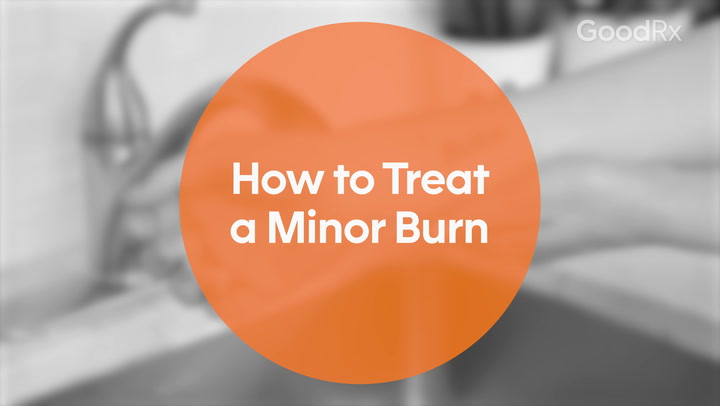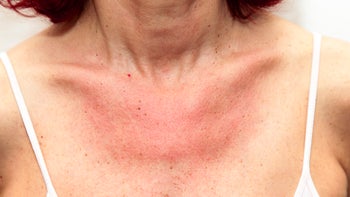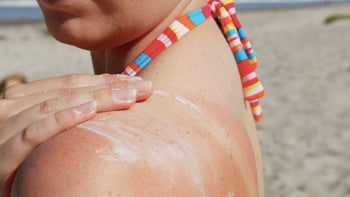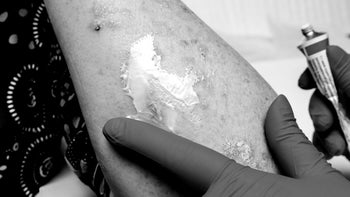
Microneedling: The Benefits and Side Effects of This Skin Treatment
Key takeaways:
Microneedling is a newer skin treatment that increases collagen production, which helps keep your skin strong and healthy.
Microneedling has many benefits and can help with wrinkles, discoloration, scars, and hair loss.
This skin procedure is generally safe, but there are some side effects to be aware of.
Table of contents

Microneedling is a newer in-office procedure that can treat different skin issues. It involves inserting tiny needles into the skin under pressure. Microneedling has gained popularity because it’s less invasive than plastic surgery and some laser procedures. Microneedling can help with skin discoloration, wrinkles, scars, and hair loss.
People lose collagen with age. So many cosmetic treatments focus on increasing the skin’s collagen. Microneedling is one of those treatments. Let’s take a closer look at the benefits of this skin procedure, how it works, and what to know about its possible side effects.
What does microneedling do?
Microneedling stimulates collagen production. To better understand this process, it helps to look deeper into the structure of your skin and its layers. The skin’s surface is like a rubber mat — smooth and protective. But below it lies the skin’s support framework. This framework is made up of mostly collagen, which helps maintain the skin’s bounce and resilience.
Search and compare options
In a microneedling procedure, the needles make tiny wounds in the skin. As your body heals these wounds, it releases growth factors. The growth factors rebuild the skin and add collagen. This strengthens and thickens the skin and restores its smoothness. It can also stimulate hair growth in areas like the scalp.
What are the side effects of microneedling?
After a microneedling treatment, your skin will be red and flushed — similar to that of a sunburn. The redness starts to go away in 1 to 2 days.
But some people may also experience symptoms, such as:
Swelling
Burning
Itching
Bruising
Soreness
Sensitivity
Dryness
If you have any of these symptoms, ice packs and nonsteroidal anti-inflammatory drugs (NSAIDs) may be helpful for any discomfort during your recovery. Your skin can take up to a week to heal.
Other risks of microneedling
Microneedling is a safe procedure. There’s minimal downtime because healing usually starts within 1 week. Unlike with certain lasers, the risk of skin discoloration is very low in people with darker skin types.
But there are some rare potential side effects. Studies have shown the risk of granuloma development when microneedling was used in combination with topical vitamin C serum. Granulomas are firm nodules underneath the skin that can last for years and can be difficult to remove. So it’s important to avoid using any topical products in the first 12 hours after treatment.
Read more like this
Explore these related articles, suggested for readers like you.
Other risks include infection, especially if the skin or microneedling instrument isn’t properly cleaned before the procedure. But there’s no risk of scarring from microneedling because the needles pierce your skin at such a shallow depth.
What is microneedling good for, and how effective is it?
Microneedling can benefit different skin issues. Because it’s fairly new, there isn’t a lot of evidence behind it. But results of clinical studies are promising. Let’s look at what research shows about how effective microneedling is for a few conditions.
Acne scars
Microneedling can be used to smooth acne scars, and it’s most effective against rolling and boxcar scars. In a small randomized trial, participants noted significant improvement in the look of their scars after three sessions of microneedling. In another study, people noticed 50% to 75% improvement in their scars after five sessions of microneedling.
Stretch marks
Stretch marks are usually difficult to treat. But microneedling has been successful in treating them.
In an early study, more than 40% of people had significant improvement in their stretch marks after three microneedling sessions. In another small study, people had at least a 50% improvement after about two treatments, and those results were still present at 1 year.
Wrinkles
Microneedling may be helpful for your skin’s health by improving the look of fine lines and wrinkles. Small studies have shown good results for improving the look of upper lip lines and necklines after two sessions of microneedling.
Microneedling with radiofrequency (RF) adds a heat component to improve collagen production. This RF technology has shown wide success in treating facial wrinkles after fewer than three treatments. While RF technology is new, studies are still emerging on how it can be used to treat acne scars and stretch marks.
Hair loss
Microneedling can also help encourage hair growth. In a trial of 100 men with male-pattern balding, treatment with microneedling and minoxidil led to greater hair growth versus treatment with minoxidil alone.
How often should microneedling be done?
For best results, repeat treatments are recommended. This means the procedure is repeated at intervals, usually 2 to 4 weeks apart. Most healthcare professionals recommend a series of three to five treatments, depending on your personalized care plan. Some people get maintenance treatments once or twice a year to maintain their results.
What to expect during a microneedling procedure
From start to finish, the entire microneedling procedure usually lasts anywhere from 60 to 90 minutes. And it doesn’t require a lot of downtime afterward. Dermatologists can do the procedure throughout the U.S. Other healthcare professionals may perform the procedure depending on each state’s regulations.
Here’s what to expect during a microneedling appointment:
A healthcare professional will wash your face with a mild cleanser. This is to remove things like makeup and sunscreen.
Then, your dermatologist will spread a numbing gel on any area that’s going to be treated.
Once your skin is numb (after about 20-30 minutes), they remove the gel with a gauze pad (which may have saline or alcohol on it).
Then you’ll lie back in the treatment chair, and your dermatologist will use the microneedling tool on different parts of the skin. This may feel like firm pressure on your skin.
They’ll usually use the microneedling tool several times over the same area in order to get the best results.
The whole treatment usually lasts about 20-30 minutes.
Afterward, your care team may apply a healing serum, like with hyaluronic acid or peptides, to the treated area.
Does microneedling hurt?
Pain is different for everybody. In general, microneedling is only uncomfortable. But most people can have topical numbing applied to their skin before their treatment. This makes it much more comfortable.
How to care for your skin after a microneedling procedure
Most dermatologists recommend that you don’t apply any lotions, creams, or makeup to the face for the first 12 hours after the procedure. This is because the skin is temporarily “open” due to the tiny wounds created by microneedling. These wounds can allow irritating factors, like allergens and lotions, to penetrate deeper than they should.
It takes about 12 to 24 hours for your skin’s epidermis — or its top layer — to heal. This healing seals off and repairs the skin barrier allowing you to use your products again.
Here are some more recommendations to care for your skin after a microneedling procedure:
Protect your skin. Keep your skin out of the sun for at least 14 days — or ideally 30 days — after the procedure.
Avoid tanning beds and self-tanning products. Don’t use tanning beds and self-tanning products for at least 7-14 days after the procedure. This is because your skin will be sensitive after microneedling. Tanning can also cause uneven discoloration, which may be permanent.
Don’t use vitamin A products. These include retinol, Retin-A, and Tazorac. These can be irritating to the skin after microneedling. Avoid them for 7 days after your treatment.
Delay chemical peels. Hold off on using chemical peels until 30 days after your treatment, as they can irritate your skin.
Don’t shave. Try not to shave the treated areas for 3-7 days after the procedure. If your skin is still irritated, wait a bit longer before shaving.
Avoid sweating, exercising, and using a Jacuzzi, sauna, or steam bath. Wait until your skin irritation has resolved, usually within 3-7 days. This is because the skin is more sensitive after microneedling and needs gentle care to heal.
Don’t use exfoliating medications or chemical products. Don’t apply exfoliating medications or chemical products or devices to your skin for at least 7 days after treatment.
The bottom line
Microneedling is a procedure that has grown in popularity in the past 20 years. By inserting tiny needles into the skin, it encourages collagen production and rejuvenates the skin. A series of microneedling procedures can be used to treat wrinkles, scars, stretch marks, and hair loss.
Although microneedling can be painful, it has very few risks. After treatment, it’s important to protect the skin from the sun and irritants to allow for it to heal.
Why trust our experts?



References
Alam, M., et al. (2014). Efficacy of a needling device for the treatment of acne scars: A randomized clinical trial. JAMA Dermatology.
Alster, T. S., et al. (2020). Microneedling treatment of striae distensae in light and dark skin with long-term follow-up. Dermatologic Surgery.
Aust, M. C., et al. (2008). Percutaneous collagen induction: Minimally invasive skin rejuvenation without risk of hyperpigmentation-fact or fiction? Plastic and Reconstructive Surgery.
Dhurat, R., et al. (2013). A randomized evaluator blinded study of effect of microneedling in androgenetic alopecia: A pilot study. International Journal of Trichology.
Dogra, S., et al. (2014). Microneedling for acne scars in Asian skin type: An effective low cost treatment modality. Journal of Cosmetic Dermatology.
Fabbrocini, G., et al. (2011). Skin needling in the treatment of the aging neck. SKINmed.
Fabbrocini, G., et al. (2012). Collagen induction therapy for the treatment of upper lip wrinkles. Journal of Dermatological Treatment.
Park, K. Y., et al. (2012). Treatment of striae distensae using needling therapy: A pilot study. Dermatologic Surgery.
Singh, A., et al. (2016). Microneedling: Advances and widening horizons. Indian Dermatology Online Journal.
Soltani-Arabshahi, R., et al. (2014). Facial allergic granulomatous reaction and systemic hypersensitivity associated with microneedle therapy for skin rejuvenation. JAMA Dermatology.
Tan, M. G., et al. (2021). Radiofrequency microneedling: A comprehensive and critical review. Dermatologic Surgery.



























